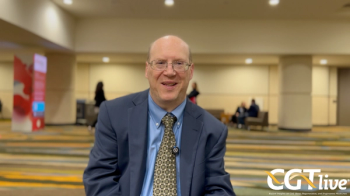
FDA Approves Fidanacogene Elaparvovec-dzkt for Moderate to Severe Hemophilia B
The decision was supported by the phase 3 BENEGENE-2 trial, which suggested that the Pfizer gene therapy was superior to standard of care FIX prophylaxis.
The FDA has approved fidanacogene elaparvovec-dzkt (Beqvez; Pfizer) for the treatment of adults with moderate to severe hemophilia B who currently use factor IX (FIX) prophylaxis therapy; or who have a history of, or current, life-threatening hemorrhage; or have repeated, serious spontaneous bleeding episodes, and do not have neutralizing antibodies to adeno-associated virus serotype Rh74var (AAVRh74var) capsid determined by an FDA-approved test.1 The therapy will cost $3.5 milion.
The biologics license application for the gene therapy was supported by
In BENEGENE-2, the patients received treatment with fidanacogene elaparvovec at a dose of 5x1011 vg/kg. It was deemed superior to SOC by investigators, reporting a mean ABR for all bleeds of 1.3 for 12 months—spanning from 12 weeks posttreatment to 15 months posttreatment—which was a 71% reduction from the lead-in study ABR (P <.0001).
Moreover, there was a 92% reduction in the annualized infusion rate of exogenous FIX following infusion with fidanacogene elaparvovec (P <.0001), and the safety profile with fidanacogene elaparvovec was consistent with prior reports from the phase 1/2 studies, Pfizer noted. Overall, there were 14 serious adverse events (SAEs) observed in 7 patients (16%), none of which were related to infusion reactions, thrombotic events, or FIX inhibitors. Two of those SAEs occurred in a single patient and were deemed related to the treatment: a duodenal ulcer hemorrhage and anemia during corticosteroid use.
“Many people with hemophilia B struggle with the commitment and lifestyle disruption of regular FIX infusions, as well as spontaneous bleeding episodes, which can lead to painful joint damage and mobility issues,” Adam Cuker, MD, MS, the director of the Penn Comprehensive and Hemophilia Thrombosis Program, said in a statement.1 “A 1-time treatment with BEQVEZ has the potential to be transformative for appropriate patients by reducing both the medical and treatment burden over the long term.”
Fidanacogene elaparvovec-dzkt is an adeno-associated virus (AAV)-based gene therapy that works by introducing a functional copy of the FIX gene encoding a high-activity FIX variant via transduced cells. The one-time
READ MORE:
In December 2023, data from a subset analysis of BENEGENE-2 were presented at the
“The limited number of participants and lack of consistent patterns and demographic features make identifying predictors of potential RTP challenging. Although all RTP participants were treated with corticosteroids during this study, not all participants treated with corticosteroids RTP of FIX. Predictors of loss of response have not been identified and further work is ongoing to potentially identify factors associated with increased risk of RTP,” Frenzel and coauthors wrote in their abstract.4
In the BENEGENE-2 trial, prophylaxis was suspended after infusion and RTP was considered at the investigator’s discretion with guidelines of at least 2 consecutive central laboratory FIX activity levels assessed to be at most 2% at least 2 weeks apart and/or at least 2 spontaneous joints bleeds within 4 weeks and/or at least 3 spontaneous bleeds overall. The 6 RTP participants had a mean age of 28.3 years (range, 18-47; 4 under 30 years) and region, race, and weight characteristics representative of the study population. These participants initially responded to the gene therapy with peak FIX activity levels over 5%, which then variably decreased with a time to RTP ranging from 155 to 623 days after infusion. Reasons for RTP included low FIX activity in 5 participants (1 with a history of intracerebral hemorrhage) and increased bleeds in 1 participant. Five participants had at least 1 bleeding event prior to RTP.4
REFERENCES
1. U.S. FDA Approves Pfizer’s BEQVEZ™ (fidanacogene elaparvovec-dzkt), a One-Time Gene Therapy for Adults with Hemophilia B. News release. Pfizer. April 26, 2024. Accessed April 26, 2024. https://www.businesswire.com/news/home/20240425269649/en/U.S.-FDA-Approves-Pfizer%E2%80%99s-BEQVEZ%E2%84%A2-fidanacogene-elaparvovec-dzkt-a-One-Time-Gene-Therapy-for-Adults-with-Hemophilia-B
2. Pfizer announces positive top-line results from phase 3 study of hemophilia B gene therapy candidate. News release. Pfizer. December 20, 2022. Accessed April 26, 2024. https://www.pfizer.com/news/press-release/press-release-detail/pfizer-announces-positive-top-line-results-phase-3-study
3. Health Canada approves Pfizer Canada's gene therapy in hemophilia B. News release. Pfizer Canada. January 3, 2024. Accessed April 26, 2024. https://www.newswire.ca/news-releases/health-canada-approves-pfizer-canada-s-gene-therapy-in-hemophilia-b-841249479.html
4. Frenzel L, Kavakli K, Klamroth R, et al. Characterizing a cohort of patients with hemophilia B treated with fidanacogeneelaparvovec from the phase 3 Benegene-2 study who returned to factor IX prophylaxis. Presented at: ASH 2023 Annual Meeting & Exposition. December 9-12; San Diego, CA. Abstract #2257
Newsletter
Stay at the forefront of cutting-edge science with CGT—your direct line to expert insights, breakthrough data, and real-time coverage of the latest advancements in cell and gene therapy.

















































